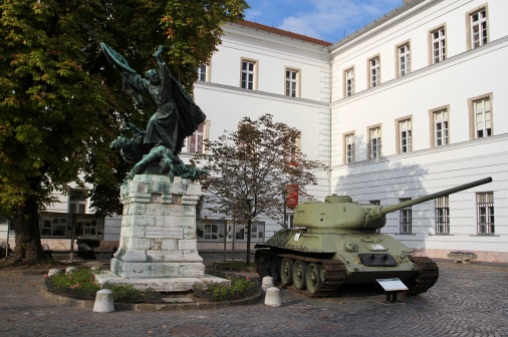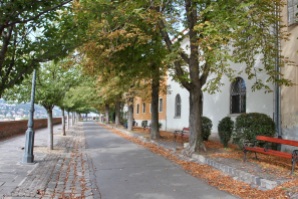If you want to experience the peaceful atmosphere of the medieval streets that make up Budapest’s glorious Castle Hill, you’ll have to get here early. By mid-morning, tour groups swarm through the narrow lanes, crowd around the beautiful 14th-century church named for King Matthias and the nearby 19th-century fortress of Fisherman’s Bastion, and make a visit to the Budapest Castle and museums an endurance test. In the early morning light the views alone make it worth the effort.



Castle Hill is a special place despite mass tourism, especially if you do the lung-bursting walk through pretty Király lépcső park. We discovered the old funicular that does the same climb in a fraction of the time only after reaching the top. The terraces outside the castle offer magnificent panoramas over the Danube and Pest. Buda and Pest were joined as one city in 1873, their historic differences are no less obvious today than in the 19th century.
The castle’s main attraction is the Hungarian National Gallery, with its collection of Hungarian artists, and a couple of smaller museums. Nothing was open this early, so we’d have to come back and face the crowds later. Instead we wandered around the castle grounds – there are several areas of ruins testifying to some of the conflicts this hilltop has witnessed – and then into the streets of the old town.
The current palace is from the reign of Empress Maria Theresa in the second half of the 18th century. Repeatedly damaged over the centuries, it was mostly destroyed during the Battle for Budapest in 1945. Defended by Hungarian and German troops, and besieged by Russian armies, there was only ever going to be one result. Hitler refused to allow his troops to retreat or surrender, so Castle Hill was pulverised. Thousands of trapped civilians died needlessly.
As you walk around the surrounding streets, the patchwork of buildings is testimony to the reconstruction undertaken by the post-1945 communist regime. Historic buildings now rub shoulders uneasily with ugly late-20th century structures, the communist authorities lacked money or materials to do a full and faithful reconstruction. Recently, the European Union subsidised more reconstruction and the area surprisingly retains its atmosphere.
We walked along a pretty escarpment that overlooked Buda and the Buda Hills, before diving into cobbled streets lined with pastel-coloured houses. Reaching the Military History Museum we were greeted by a Russian T34 tank, the workhorse of the Soviet armies in World War II – Berlin has a couple parked outside the Soviet Memorial in the Tiergarten. The Church of Saint Mary Magdalene towers over this area and, when it’s open, the tower offers spectacular views.
Castle Hill is a compact area that doesn’t take too long to explore on foot. We found ourselves outside the Matthias Church, which, with its coloured tiled roof and a history dating back to the 11th century, is one of the most interesting churches in Budapest. Legend has it that during the 1686 siege of Budapest – when Christian armies were attempting to end 150 years of Muslim Ottoman rule – artillery fire hit the wall of the church.
The wall crumbled to reveal a statue of the Virgin Mary, bricked up after the Ottoman conquest of 1541. This allegedly disheartened the Ottoman defenders to such an extent that they immediately surrendered. Today, it’s as if the church has surrendered to tourism. Close by is Fisherman’s Bastion, which offers glorious views over the city if, that is, you can squeeze onto the balcony past the tourist hoards invading the modern city.
It was time for lunch, but not in this touristy area. We walked to Budapest-Deli railway station from where a tram whisked us back over the majestic Danube into the centre of Pest for an excellent modern Hungarian lunch at Kőleves Vendéglő.























I am always amazed at the vast quantity of History every where in Europe… So wish more people remembered. Thanks for the “tour”, Paul.
Thanks, Brian. Last week was the 75th anniversary of the liberation of Auschwitz-Birkenau – it seemed to pass with little fanfare, even in Europe. I read two bits of research (one from the US and one from France) indicating levels of knowledge about the Holocaust were alarmingly low, even amongst adults. The same would be true in many other countries no doubt. If we lose our collective memory of the Holocaust, we really are headed towards a very dark place.
We are headed towards a dark place. Little doubt about that. Memory has faded into History and into Oblivion. Paul Ricoeur’s book is opening before our own eyes. I have heard the phrase “the world Jewish conspiration” at a dinner recently. And not a redneck dinner… Alas.
Alas indeed. It’s pretty hard to understand, have people always preferred conspiracy theories to reality?
Probably so. I’m reading Tocqueville’s “Democracy in America”. Rationality was already a problem then. Did I tell I heard the phrase “The world Jewish conspiracy” in a dinner recently? And the person who said that is fairly… “normal”… 😦
Even with all the tourists and modern buildings you were able to take amazing pictures. Budapest is a city I’ve always wanted to see. Maybe one day…